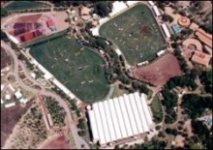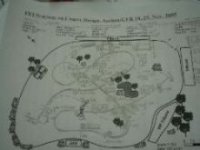The horse's field of vision
The horse's eye are placed at the side of his head, and he has a lateral field of vision of 160-170 degrees on either side of him. The horse can use both eyes independently (this is known as monocular vision) or both eyes together (known as binocular vision). The very small field in front of him is the binocular vision field which allows him to judge distances. To see objects at a short distance a horse must also focus the lens The bigger field, the monocular vision field, allows him to independently see clear more distant objects. If something is disturbing the horse at the side of him, he will use his eyes monocularly and then he will not see clearly, the small area immediately in front of him - he will see only, clearly to either side.
Head at 45 degrees
With the head at this angle, the horse can clearly see the area in front of him (2), when using his eyes binocularly. Above and below this area (1 and 3) is an area of blurred vision and, higher up, there is a blind spot (4).
With the head at this angle, the horse can clearly see the area in front of him (2), when using his eyes binocularly. Above and below this area (1 and 3) is an area of blurred vision and, higher up, there is a blind spot (4).
پیوست ها
آخرین ویرایش:















































